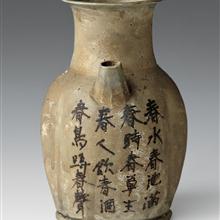Dimensions: Height: 16.4cm; diameter at mouth: 5.8cm
Origin: Unearthed in a well at Siqian street, Hengyang in 1973
As a utensil used to handle water, the ewer could be used as a handled ewer or carried with strings attached. Mould applied design is another important decorative feature of the Changsha Kiln, this applied ewer is a fine example of this. The ewer, with a small curvy mouth, a deep body and two holes on both shoulder sides, has a short octagonal spout. It is decorated with three applied designs under the two sides and the spout. Below the spout is a dancing figure wearing a gauze handkerchief and dancing gracefully on a cattail hassock. On the left there is a square pagoda design while on the right is a lion design.
In ancient China, Gold and silver were mainly used with jewelry while they were used in food containers in East Asia. During the Tang Dynasty, as communication increased between the western regions and China, gold and silver implements were brought from Persia to China. The making of gold and silver was greatly influenced by craftsmanship from the west, which extended its impact to the porcelain industry. Mould applied design was initially used in tri-color-glaze Tang Porcelain. It usually appears in 3 areas, either the lower part of the ewer with the trumpet-shaped mouth, mainly for Buddhism related matters, the ear*** of the ewer which mainly used mould applied design, or most commonly the belly of the ewer.
Mingled with culture of the Western region, these products were always made for export.
On these three mould applied designs, dancers play the central part. The dance is quite different from the traditional ones in China. This kind of dance is expressed in a different way by directly inspiring people with artistic feeling through the curves and muscles of the human body. This kind of dance is called “Huteng Dance” or “Huxuan Dance” and it was brought from the western regions during the Tang Dynasty and later became popular nationwide. This ewer is proof of transculturation between middle Asia and China.





